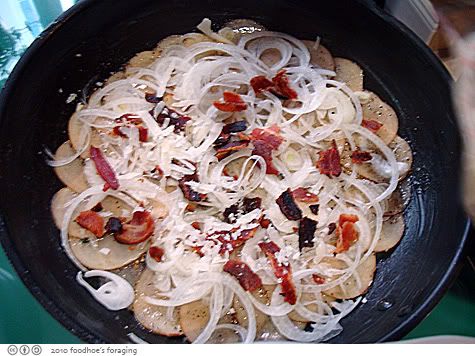
From Elizabeth Andoh's amazing cookbook
Washoku: Recipes from the Japanese Home Kitchen
Serves 6 to 8
1 Japanese leek or small western leek, about 3 oz
1/2 tsp vegetable oil
6 oz boneless pork from loin or shoulder, cut into small, thin strips
1 small carrot, about 3 oz, peeled and cut into julienne
1-inch chunk daikon, abou t2 oz, peeled and cut into julienne
5 to 6 inches burdock root, about 3 oz, rinsed and lightly scraped and cut on the diagonal into thin slices
Pinch of salt
splash of sake
2 quarts water
about 12 square inches kombu
1/2 tsp soy sauce
1 block firm tofu, about 14 oz, drained and pressed, then cut into 1/4 inch dice
1 small bunch mitsuba about 15 stalks, trimmed, stems cut into short pieces, and leaves choped
3 tablespoons mugi miso
3 tablespoons sweet, light miso, preerably Saikyo miso
Trim away the hairy troot and any tough green top of the leek and then cut in half lengthwise. Rinse under cold water to remove any grit or oil. Place the cut edges down on a cutting board and slice on the diagonal into thin strips. SEt aside.
Heat the oil in a deep pot over high heat. Stir-fry the pork for 1 minutes, or until it begins to color. Then add the leek, carrot, caikon and burdock root and continue to stir-fry over high heat for 1 minute. Add the salt and sake, and stir fry for 1 to 2 minutes, or until the burdock root emits a woodsy aroma.
Add the water and kombu. When the soup begins to boil, skim away any froth and reduce the heat to maintain a steady but not vigorous simmer. Continue to cook, skimming away froth as neede, for 4 to 5 minutes or until the vegetables are very tender and the pork is thoroughly cooked. Remove and discard the kombu. Season with the soy sauce. Add the tofu to the soup and simmer for 1 minute to heat it through.
Divide the mitsuba evenly among individual soup bowls (I used parsley since I couldn't find mitsuba).
Just before serving, place the miso in a separate bowl, ladle in some of the hot stock from the pot, stir to mix it, and then add to the pot.
Ladle the soup into the bowls. The brief exposure to hot soup is sufficient to cook the mitsuba. Serve immediately.
Many version of tonjiru substitute scallions for leeks and include some kind of mushroom. You can also use a pungent dark miso, such as Sendai miso to balance the flavors.

































